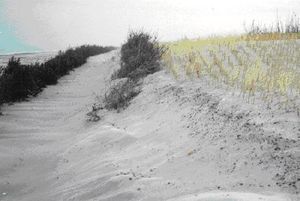Dune stabilisation
Dunes are a natural coastal feature on moderately exposed and exposed coasts. Dunes are formed by the sand, which blows inland from the beach and is deposited in the area behind the coastline.
Contents
Background
During storm surge events, the foot of the dunes can be eroded, but the dunes act as a very flexible buffer zone, which protects the hinterland from erosion and flooding. The eroded material supplies material to the littoral budget minimising the general erosion along the entire section of shoreline. During the storm and also during more normal events, sand will be transported inland, sometimes in connection with the formation of wind alleys in the dune row. After the storm, the damaged dune will gradually be built up again, maybe slightly more inland. This means that a dune acts as a natural flexible coast protection and sea defence measures. It moves backwards parallel with the eroding coastline and at the same time it maintains its form and volume as well as a wide beach. This is a natural quasi-equilibrium situation.
However, the natural balance will shift if the dune vegetation is damaged by grazing or if beach-users, etc. generate too much traffic, etc. This may cause the dunes to degrade resulting in loss of the protection provided by the natural dunes. At the same time the sand blowing inland causes various kinds of damage. Consequently, authorities normally tend to protect dunes by regulating their use.
In some cases authorities have been very eager to protect the dunes by planting marram grass and placing fascines in the wind alleys to trap the sand. (Fascines are the placing of pine or spruce branches). This has, in some cases, resulted in a complete fixing of the dune position and an unnatural growth in height. Consequently, the flexibility of the natural dune is lost resulting in a gradual disappearance of the dune due to erosion, whereby the protection, provided by the natural dune system, is lost.
Method

Planting marram grass and setting up spruce fascines for trapping of sand and enhancement of dune build up. Larger wind alleys can also be filled artificially prior to planting. However, as mentioned above, the protection should not be so comprehensive that it completely fixes the dunes.
Newly planted vegetation in particular can be strengthened by using fertiliser.
Restrictions for their use can also protect the dunes. Grazing in dune areas is prohibited in most countries, and authorities often limit public access. Such restrictions may regulate the traffic in the dunes, e.g. by prohibiting motor traffic. Different options are paved walking passages in areas near parking lots and fencing fragile newly planted areas.
Functional characteristic
Dune stabilisation is a sustainable protection measure, enhancing the natural protection ability of dune areas. It protects against wave and storm surge attack and at the same time it preserves the natural coastal landscape, if performed moderately. Dune stabilisation requires a planned and co-ordinated effort.
Applicability
Dune stabilisation is applicable on all coastal types where natural dunes occur. This is especially the case on moderately exposed to exposed coasts with perpendicular to very oblique wave (wind) attacks, types 1M to4M and 1E to 4E.
Artificial dunes are also used as a sea defence structure.
References
- ↑ Danish Coastal Authority, 1998. "Menneske, Hav, Kyst og Sand". (in Danish), (Man, Sea Coast and Sand in English). Kystinspektoratet 1973-1998.
Please note that others may also have edited the contents of this article.
|
[[Category:Articles by {{{AuthorFullName}}}]]
Further reading
- Mangor, Karsten. 2004. “Shoreline Management Guidelines”. DHI Water and Environment, 294pg.
return to